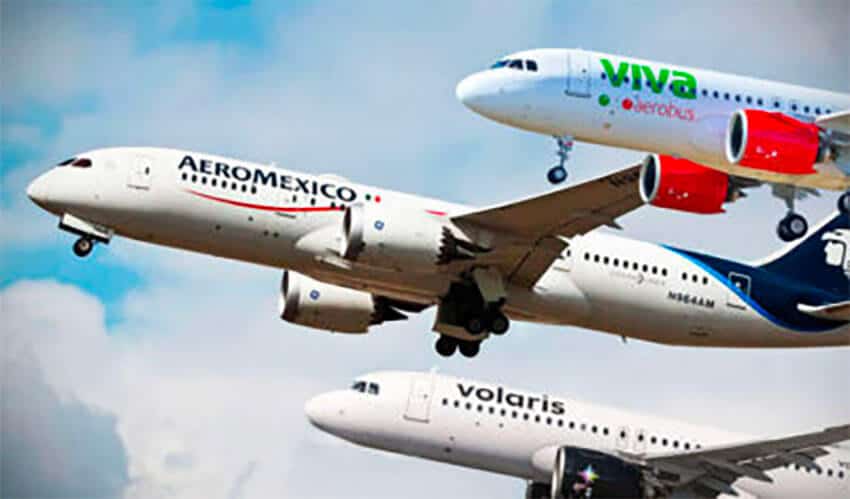A senior transport official said Monday that operations at the Mexico City International Airport (AICM) will be reduced to avoid more dangerous incidents such as that seen last Saturday when a plane had to abort its landing to avoid colliding with another aircraft waiting to take off.
Deputy Transport Minister Rogelio Jiménez Pons said 25% of flights will be transferred to the Felipe Ángeles International Airport (AIFA) and the Toluca International Airport over the next 12 months.
The migration of flights from the saturated AICM will begin in August, he said in a radio interview.
At a meeting with government officials on Monday, representatives of Volaris, Aeroméxico and VivaAerobús expressed their willingness to shift some flights, Jimenez said.
Those three airlines all have a large number of operations at the AICM, he said. “What we’re proposing is an objective … [over] 12 months to achieve a reduction of 25%,” Jiménez said.
“The [Mexico City] airport has been saturated and in terrible conditions for decades,” he added.
The deputy minister said the broader objective is to distribute airline traffic across five airports in central Mexico: the AICM, the AIFA, Toluca, Puebla and Cuernavaca.
Located about 50 kilometers north of downtown Mexico City, the AIFA opened in late March but is currently only handling a very limited number of operations.
With regard to Saturday’s incident involving two Volaris planes, Jiménez confirmed that an air traffic control mistake was to blame. A flight arriving from Mazatlán was cleared to land on a runway where a plane was waiting to take off to Guatemala City.
Jiménez said that a shift change may have contributed to the blunder.
“There is possibly an issue that we’re checking now. … [We have to check] whether there was a shift change,” he said, raising the possibility that different air traffic controllers provided instructions to the two Volaris planes involved in the incident.

“We have to check that, because then there would be two people responsible,” Jiménez said. He described the incident as a “frightening situation” but asserted that people’s safety was not placed at risk.
“The defense of the pilots was put to the test and thank God, these people are prepared,” the deputy minister said.
According to air traffic controllers and aviation experts cited by the newspaper Reforma, the number of aborted landings, or go-arounds, has doubled at the AICM this year due to the redesign of air space to allow that airport and the AIFA to operate simultaneously.
There was an average of three go-arounds for every 1,000 operations at the AICM in the first four months of the year between 2019 and 2021, the sources estimated. That figure increased to six between January and April of 2022, they said. No official data on aborted landings is published.
“The number of go-arounds has increased since August 2021 but they have been more recurrent this year,” an AICM operations commander said.
“We calculate that the rate is five, almost six [go-arounds per 1,000 landings], mainly due to the redesign [of air space] in order to coexist with the AIFA,” he said.
Juan Antonio José, an aviation expert, told Reforma there are up to 10 go-arounds per day at the AICM, where there are some 450 landings every day.
Alfredo Covarrubias, head of the National Air Traffic Controllers Union (Sinacta), confirmed that go-arounds have increased to about six per 1,000 landings. He also said that aircraft incidents have increased 300%.
“Among controllers it was previously a scandal to have an incident. … Now it’s becoming a normality and they prefer not to file a report when things happen because there are reprisals,” Covarrubias told a press conference on Monday.
He said that about 30 serious incidents have been reported in Mexico over the past four months, including 10 at the AICM.
Air traffic controllers cited by Reforma said incidents were kept secret when Víctor Hernández was director of Navigation Services for Mexican Airspace, a government agency. Hernández was dismissed after Saturday’s incident and replaced by Ricardo Torres Muela, who has over 40 years’ experience as an air traffic controller.
According to Sinacta, there is a shortfall of some 300 air traffic controllers across Mexico, meaning that those employed at the nation’s airports have to work long shifts. The union also says that controllers lack training.
The International Federation of Air Line Pilots’ Associations said last week that it appeared that air traffic controllers at the AICM have received little training and support as to how to direct flights operating in the new airspace configuration.
Last May, the United States downgraded Mexico’s aviation safety rating, a move that prevents Mexican airlines from adding new flights to the U.S.
The Federal Aviation Administration (FAA) said it downgraded Mexico from Category 1 to Category 2 after finding that it didn’t meet standards set by the International Civil Aviation Organization (ICAO), a specialized agency of the United Nations.
“The FAA identified several areas of noncompliance with minimum ICAO safety standards,” the aviation authority said in a statement.
“A Category 2 rating means that the country’s laws or regulations lack the necessary requirements to oversee the country’s air carriers in accordance with minimum international safety standards, or the civil aviation authority is lacking in one or more areas such as technical expertise, trained personnel, record keeping, inspection procedures, or resolution of safety concerns.”
With reports from Milenio, Radio Formula and Reforma
